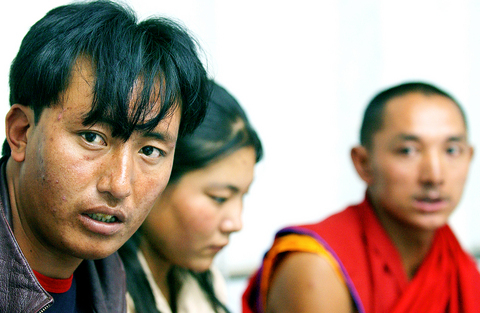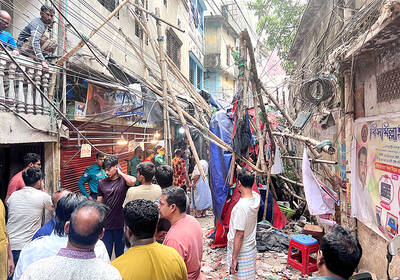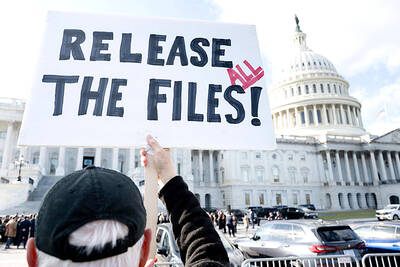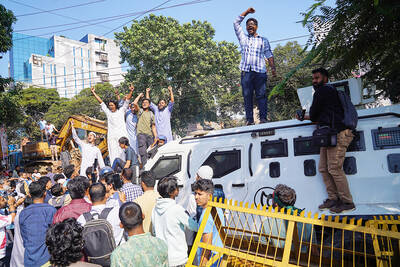For 17 days they waded through Himalayan snowdrifts and climbed ice-covered rocky terrain, cold, hungry and exhausted. Then came the shooting.
Early on Sept. 30, as 75 Tibetan refugees were making a secret trek across the border into Nepal, moving in single file across a mountain slope near the 5,800m high Nanpa La Pass, Chinese border guards opened fire.
One woman -- a 25-year-old Buddhist nun -- was killed immediately, group members said. Chinese officials, in a statement apparently about the shooting, have said a second person also died.

PHOTO: AFP
"There was no warning of any kind. The bullets were so close I could hear them whizzing past," Thubten Tsering, a Tibetan monk, told journalists in New Delhi on Monday. "We scattered and ran."
Thubten is among 41 of the refugees who survived the shooting and reached India. The survivors said they do not know the fate of 32 others, including nine children, who were taken into custody by the guards.
"We don't know where they are or what happened to them," said Thubten, his chapped cheeks and exhausted face still bearing the scars of the ordeal.
Footage of the incident, shot by a Romanian cameraman on a mountaineering expedition, sparked an international outcry.
The footage, which was released by Romania's Pro TV, shows a distant figure that its narrator says is a Chinese border guard firing a rifle and a separate scene of a person in a line of figures walking through the snow then falling to the ground. An unidentified man near the camera can be heard saying in English, "They are shooting them like, like dogs."
The activist group International Campaign for Tibet, in a written statement, said the video proves Chinese troops fired at unarmed Tibetans and counters a statement from Beijing that its forces were attacked and fired in self-defense.
The pass is a common escape route for fleeing Tibetans.
Thousands have left for Nepal since Chinese forces occupied their Himalayan homeland in 1951. Many make their way to the north Indian town of Dharmsala, the home of the Dalai Lama, the exiled Tibetan Buddhist spiritual leader and a Nobel Peace Prize laureate.
Every year more than 2,500 Tibetan refugees attempt the arduous trek, said Tenzing Norgay of the Tibetan Center for Human Rights and Democracy, which arranged the Monday news conference for the survivors.
When asked about his life in a monastery in Tibet where the monks are under the constant watch of Chinese security forces and under pressure to denounce the Dalai Lama, Thubten said simply: "It was stifling."
"Being a monk who has taken a vow to live by the faith, we were always under threat from the Chinese political authorities," he said.
Dolma Palkyid, a 15-year-old novice nun, was a close friend of Kelsang Nortso, the nun who was killed.
"I had walked ahead and we got separated. Then the shooting took place and we fled. It was four days later that I heard Kelsang was the one who was shot," she said, speaking haltingly and tearfully, through an interpreter.
Once in India, the friends were hoping to join another Buddhist nunnery together, said the red-cheeked teenager dressed in a traditional ankle-length gown.
The group of Tibetan refugees had each paid 5,000 yuan (US$625) to a guide to arrange the trip. They set off around the middle of last month, assured that the 10-day trek would deliver them to Nepal.
There have been instances of refugees being shot at by border guards in the past, but this was the first time in recent years that troops killed any, Tenzing said of the human rights group.
"This is the first time that the world has seen evidence of what Tibetans are subjected to by the Chinese," Tenzing said.
"Kelsang's death cannot go in vain. We will use this incident and the video footage to bring international pressure on China and press for Tibetan freedom," he said.

DISASTER: The Bangladesh Meteorological Department recorded a magnitude 5.7 and tremors reached as far as Kolkata, India, more than 300km away from the epicenter A powerful earthquake struck Bangladesh yesterday outside the crowded capital, Dhaka, killing at least five people and injuring about a hundred, the government said. The magnitude 5.5 quake struck at 10:38am near Narsingdi, Bangladesh, about 33km from Dhaka, the US Geological Survey (USGS) said. The earthquake sparked fear and chaos with many in the Muslim-majority nation of 170 million people at home on their day off. AFP reporters in Dhaka said they saw people weeping in the streets while others appeared shocked. Bangladesh Interim Leader Muhammad Yunus expressed his “deep shock and sorrow over the news of casualties in various districts.” At least five people,

The latest batch from convicted sex offender Jeffrey Epstein’s e-mails illustrates the extraordinary scope of his contacts with powerful people, ranging from a top Trump adviser to Britain’s ex-prince Andrew. The US House of Representatives is expected to vote this week on trying to force release of evidence gathered on Epstein by law enforcement over the years — including the identities of the men suspected of participating in his alleged sex trafficking ring. However, a slew of e-mails released this week have already opened new windows to the extent of Epstein’s network. These include multiple references to US President Donald

LEFT AND RIGHT: Battling anti-incumbent, anticommunist sentiment, Jeanette Jara had a precarious lead over far-right Jose Antonio Kast as they look to the Dec. 14 run Leftist candidate Jeannette Jara and far-right leader Jose Antonio Kast are to go head-to-head in Chile’s presidential runoff after topping Sunday’s first round of voting in an election dominated by fears of violent crime. With 99 percent of the results counted, Jara, a 51-year-old communist running on behalf of an eight-party coalition, won 26.85 percent, compared with 23.93 percent for Kast, the Servel electoral service said. The election was dominated by deep concern over a surge in murders, kidnappings and extortion widely blamed on foreign crime gangs. Kast, 59, has vowed to build walls, fences and trenches along Chile’s border with Bolivia to

DEATH SENTENCE: The ousted leader said she was willing to attend a fresh trial outside Bangladesh where the ruling would not be a ‘foregone conclusion’ Bangladesh’s fugitive former prime minister Sheikh Hasina yesterday called the guilty verdict and death sentence in her crimes against humanity trial “biased and politically motivated.” Hasina, 78, defied court orders that she return from India to attend her trial about whether she ordered a deadly crackdown against the student-led uprising that ousted her. She was found guilty and sentenced to death earlier yesterday. “The verdicts announced against me have been made by a rigged tribunal established and presided over by an unelected government with no democratic mandate,” Hasina said in a statement issued from hiding in India. “They are biased and politically motivated,” she